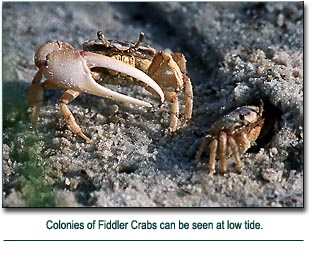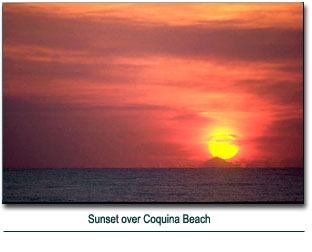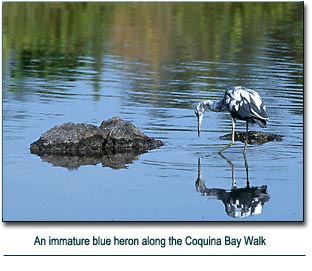Doing some nature photography in Florida this winter and want to try somewhere different? Check this out...
 Coquina Bay Walk at Leffis Key in west central Florida is popular with the locals and winter residents as a place to take a daily walk while enjoying the company of Florida's most beautiful wading birds. It is also well known by visiting birders who, with binoculars in hand, excitedly add new sightings to their birding life list. Among the species that visit Coquina Bay are great blue herons, little blue herons, white egrets, green herons, night herons, brown and white pelicans, as well as less popular reddish egrets, tricolored herons, and an occasional magnificent frigatebird. Birds in breeding plumage and mottled juveniles can also be spotted in the winter and early spring.
Coquina Bay Walk at Leffis Key in west central Florida is popular with the locals and winter residents as a place to take a daily walk while enjoying the company of Florida's most beautiful wading birds. It is also well known by visiting birders who, with binoculars in hand, excitedly add new sightings to their birding life list. Among the species that visit Coquina Bay are great blue herons, little blue herons, white egrets, green herons, night herons, brown and white pelicans, as well as less popular reddish egrets, tricolored herons, and an occasional magnificent frigatebird. Birds in breeding plumage and mottled juveniles can also be spotted in the winter and early spring.
My first trip to Coquina Bay Walk was on an early March morning. I read about it in Florida Wildlife Viewing Guide. It was less than an hour from my home and I was hopeful of a new location to observe and photograph birds and other marine life in their natural coastal habitats. I was not disappointed. Extensive footpaths and boardwalks lead visitors through 30- acres of meticulously restored wetlands. Birds feed peacefully in the tidal lagoons within 30-100 feet from the trail. One can observe pelicans diving for fish and gliding in line formation over the bay from one of several boardwalks that extend over the open water. Ospreys are also plentiful. A few species of warblers and other passerine birds inhabit the upland areas.
A great abundance of marine life breed in the shallow lagoons, leaving their young to grow within the relative protection of the mangrove trees and man made sand dunes. These waters, buffered from the wind and strong tidal forces, serve as nurseries for many species of fish and crabs. While many of these juveniles reach maturity and replenish the intracoastal waterways with a healthy supply of aquatic life, others are a food source for the birds and fish that feed within this interdependent ecosystem. Marine life found at Coquina Bay Walk includes horseshoe crabs, fiddler crabs, blue crabs, whelks, conchs and ragged sea hares and many species of small fish.

The vegetation within this Estuary is as diverse as the birds and marine life it protects. Red, black and white mangroves fringe the shoreline, while sea oats, sea grapes and other native coastal plants provide shelter and erosion protection for the wetland habitats. On the sand dunes, the beautiful beach morning glory and railroad vine creep up the hills, adding splashes of violet and white to the golden grasses. In the salt marshes, ripe glasswort, backlit by the sun, glows a translucent red. Saw grass and other salt tolerant plants line the trails while sea daisies, beach sunflowers and seaside goldenrod paint the landscape.
While rich in wildlife and native vegetation, the area where Coquina Bay Walk at Leffis Key now sits was not always so pristine. It is the result of a highly successful restoration project designed to re-create native habitat on 30 acres of public land that had been destroyed by dredging of the Intercoastal Waterways during the 1950's. The disposal material from the dredging was deposited over a mangrove island that created the peninsula known as Leffis Key. Subsequently the sea grass beds were covered up by the dredging disposal and non-native vegetation invaded the coastline.
The restoration of Leffis Key began after 1987, when Congress established the National Estuary Program (NEP) to provide funds for protecting coastlines and estuaries. The Sarasota Bay National Estuary Program drafted the initial proposal for funding along with the Florida Department of Environmental Protection and Manatee County. The objectives of the project was to; restore native habitat on a 30-acre dredged material site; revive functional mangrove, wetland and shallow water habitats; improve water circulation in the bay; provide habitat for spawning and juvenile fish; and provide public access and opportunities for education and enjoyment in the outdoors.

The first step in the restoration project was to remove exotic species, followed by excavation of intertidal pools and inlets. A channel was excavated through the peninsula to restore tidal circulation in the bay. Fill material from the key was used to create dunes to serve as protective barriers. Finally, boardwalks and walkways were constructed for public access. Volunteers planted over 50,000 native salt marsh, intertidal and upland trees and plants and interpretive signage was installed. The success of the Coquina Bay at Leffis Key restoration project is a model for other wetlands restoration projects.
Nature photography at Coquina Bay Walk is at its peak in the winter and early spring, but birds can be found anytime of year. Mornings are nice for the early light on the bay side of the park, while evenings allow you spend more time shooting the intertidals at Coquina Bay Walk, then cross the street to catch a sunset over the Gulf. If you can plan your shoot for low tide, you may be rewarded with dozens of species of birds feeding in the grassy shallows and on the sand bars in the bay.
While a real long lens might be useful for photographing birds feeding way out on the bay flats, there is plenty to shoot at Coquina Bay Walk that doesn't require a lens longer than 300mm. I usually carry my 300mm, and use it with and without my 1.4 TC. The nice feature of the park is that if you do want to haul around lots of equipment, the trails and boardwalks are well designed and maintained, with plenty of benches for resting or changing a lens.
Coquina Bay Walk at Leffis Key is located on the Gulf Coast in west central Florida. It is directly adjacent to Coquina Beach on the southeast tip of Anna Maria Island, just north of Longboat Key. From Interstate 75, take exit 42 (hwy 64) west 13 miles to Anna Maria Island. Turn left onto Gulf of Mexico Drive (Florida 789) and drive south 3.5 miles. The site entrance is on the left (east) side of the road.
Editor's Note - You can view more images from Coquina Bay Walk on Donna's website.
DB-NPN

